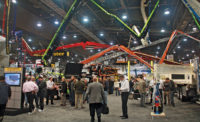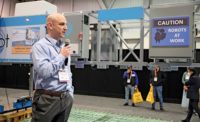With a climb seen in U.S. construction activity and a sense that equipment makers may finally have absorbed price hikes from decades of emissions-compliance upgrades, activity was brisk at the World of Concrete show, held in Las Vegas on Jan. 23-26.

“No matter how you look at it, the near-term economy is in good shape,” says Ed Sullivan, chief economist with the Portland Cement Association. “And [our analysis shows] you can take that and translate it into factors that will force construction activity.”
Sunny economic news was only one sign of the optimism at the show, which covered 747,000 sq ft of exhibit space and drew 58,222 registered attendees over the course of the week, according to official estimates. Construction-industry professionals walked past displays from 1,567 exhibitors, including 302 companies that were new to the show. According to the show organizers, it was the largest World of Concrete in nine years.
While there are positive signs for the near future, PCA’s Sullivan also cautions that, in the coming years, a number of factors may limit growth, including a collision of the ongoing skilled-labor shortage with expected immigration restrictions (see related story, p. 8). The construction industry relies on undocumented immigrants to “support construction activity and trades,” Sullivan says. “When you clamp down, you restrain those sources of workers. That’s not good.” But despite the continued pressure on the labor force and the possibility of inflationary worries in the next few years, Sullivan’s forecast for concrete was upbeat, with U.S. portland-cement consumption expected to grow 2.6% in 2018, followed by steady increases of 4.5% and 6.4% in 2019 and 2020, respectively.
The lure of seeing the latest equipment up close is the main draw for most show attendees, and manufacturers brought out their latest updated machines for the crowds. Compact equipment is a growth market for many manufacturers, and there were new skid steers from major brands scattered across the show floor. John Deere showcased its new midsize G-Series skid-steer and compact-track loaders, boasting features intended to improve the life span and maintenance of the heavily worked machines, such as a flip-up cab for easier access to the engine.
“The market [for compact loaders] is explosive right now,” says Gregg Zupancic, Deere product marketing manager for skid steers and compact track loaders. “Folks that would buy a bigger product like a dozer or loader, their prices have gone up as we transitioned as an industry with emissions controls. They are looking for other solutions at a more economical price point.”
Compact equipment was also the centerpiece of the Gehl display, where its new Pilot series of compact track loaders was highlighted. Following the trend toward easier maintenance, the Gehl loaders feature automatic track tensioning, which ensures proper track tension when the engine is started and relieves that pressure when the engine is shut off. This feature also allows the loader’s tracks to be replaced in as little as 20 minutes, according to a Gehl spokesperson.
Rising demand prompted some manufacturers to relaunch machines that had been retired in leaner times. The Pettibone Traverse T944X telehandler features a laterally extending carriage, providing an extra 70 in. of horizontal reach when operating at the full boom length of 44 ft. Pettibone had ceased production of the earlier traverse-telehandler model in 2013, but market forces and new engine options to meet EPA Tier 4 Final emissions standards prompted the return. “We bowed out of that industry for a while,” admits Kyle Rubin, Pettibone’s sales and marketing director. “But we did see a lot of customers asking for it the past few years, so we’re excited to bring it back.”
More-economical options also motivated Terex Advance to redesign its front-discharge mixer truck. The new Charger Series trucks, unveiled at the show, offer the benefits of a front-discharge truck on a machine that is light enough to work on urban jobsites. “We’ve kept everything [our customers] have liked about our front-discharge mixer trucks, but we’ve addressed the pain points,” explains Mark Aubry, Terex Advance director of customer engagement. The machines also feature a lower charging height, and later models will feature a smaller wheelbase to improve maneuverability in urban jobsites, where space is limited.
First Look at New Innovations
While most of the heavy-equipment and concrete tools on display at the show represented moderate updates to existing product lines, there were a few stand-out items on display. Chemical giant BASF featured its Wabo Trident bridge-expansion joint, a seismically friendly update to the classic finger joint used in bridges. Fresh from the engineers at BASF subsidiary Watson Bowman Acme, the Wabo Trident (seen at far left) consists of segmented members mounted on bolts, allowing the joint to move laterally as well as longitudinally. This modular system can be adapted to any bridge-expansion joint where a finger-style joint would otherwise be used, according to a Watson Bowman Acme spokesperson.
While most of the products at the show tended to focus on the dirty work of concrete placement, the tech booths had a few new tricks. Trimble has passed a major milestone on its efforts to bring Microsoft’s HoloLens mixed reality to jobsites, receiving ANSI certification for a hardhat-mounted version of the viewing headset. Workers will be able to view 3D models in the real space of the site, with the headset’s spatial-awareness software mapping the model onto nearby surfaces. In order to meet safety regulations, the headset can be quickly snapped off the hardhat, allowing the worker to safely walk the site without distractions.
Another hit at the show was Construction Robotics’ Mule, a pneumatic arm that allows masons to move and place concrete masonry units without having to bear the weight. The Mule is mounted on a modular mast that can be attached to scaffolding or moved with a forklift. Hardened to work outdoors in rough weather, the Mule requires only a standard 110V power source to operate.
Right across the lane from the Construction Robotics’ Mule and its always-popular Semi-Autonomous Mason robot, crowds cheered at the Spec Mix Bricklayer 500 World Championship competition. Teams of masons and tenders competed to build the tallest 26-ft, 8-in.-long, double-wythe brick wall they can in an hour. As always, it was a close race, but last year’s champion—Matt Cash of Huntley Bros. Co. in Mint Hill, N.C.— fell short. In the end, it was mason David Chavez of Ranch Masonry, Houston, and his 698-brick wall (with a rare zero deductions for errors) that took home the title of World’s Best Bricklayer 2018. He received $120,000 in cash and prizes, including a brand-new Ford F-250 XLT Super Duty pickup truck.







